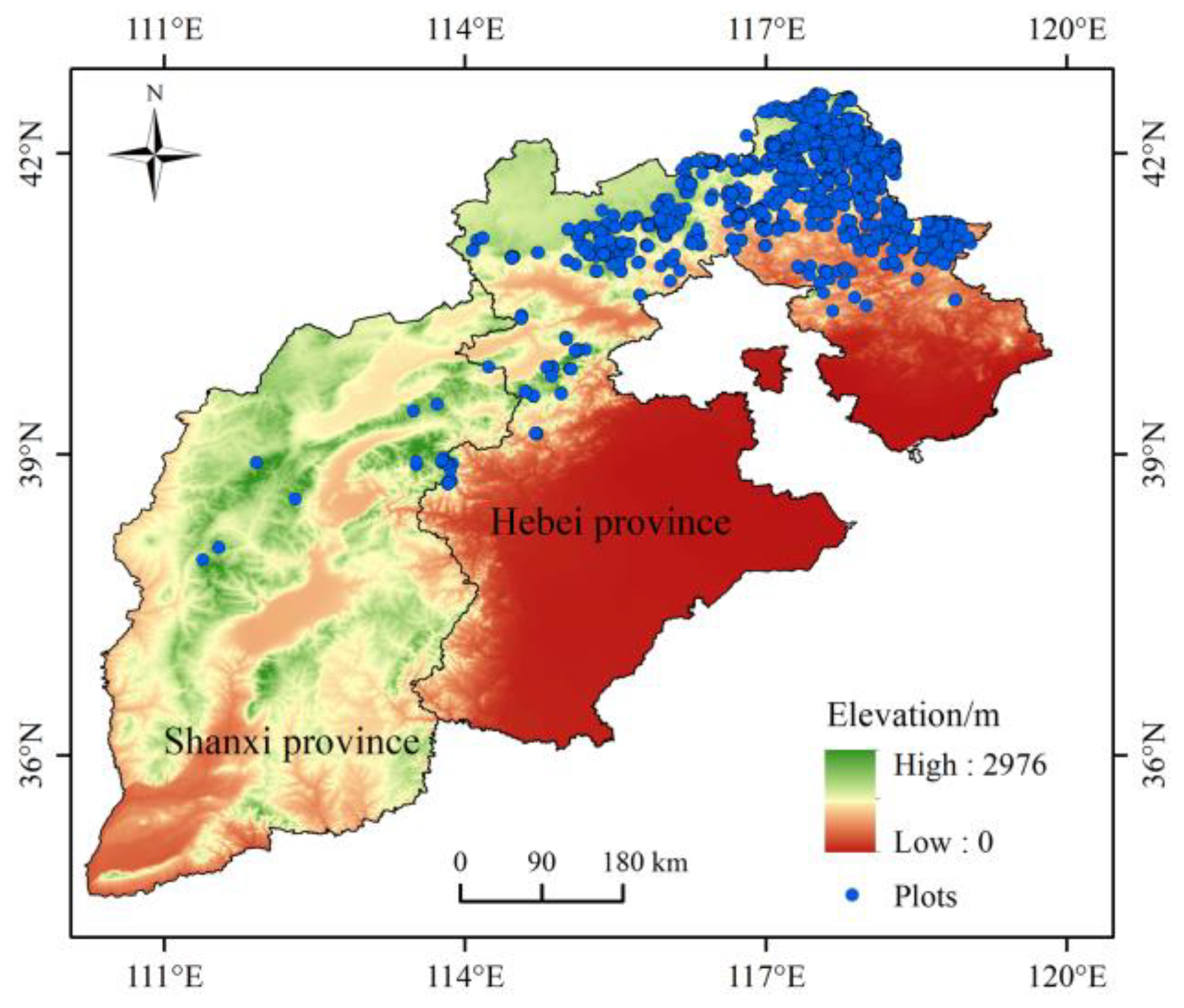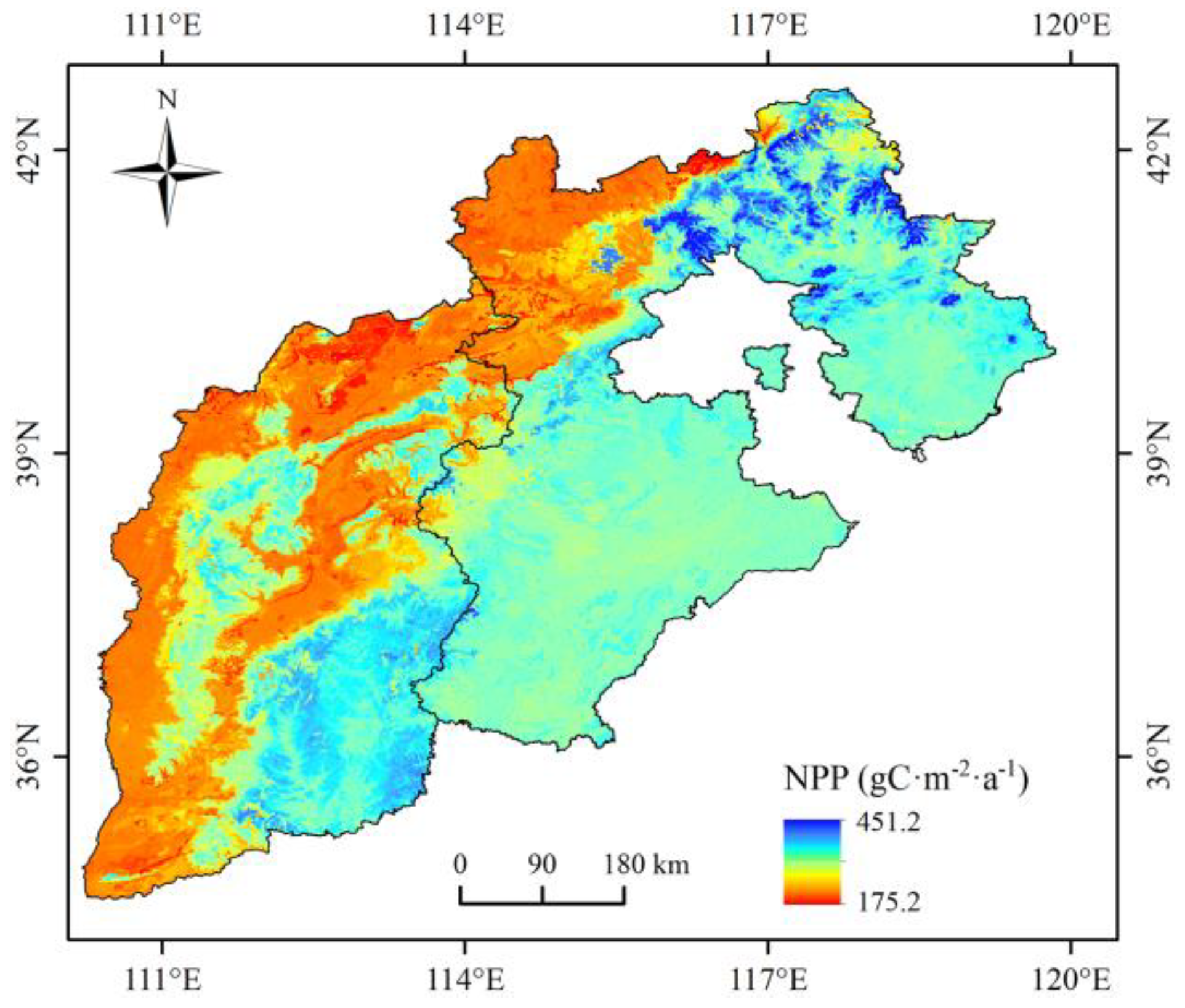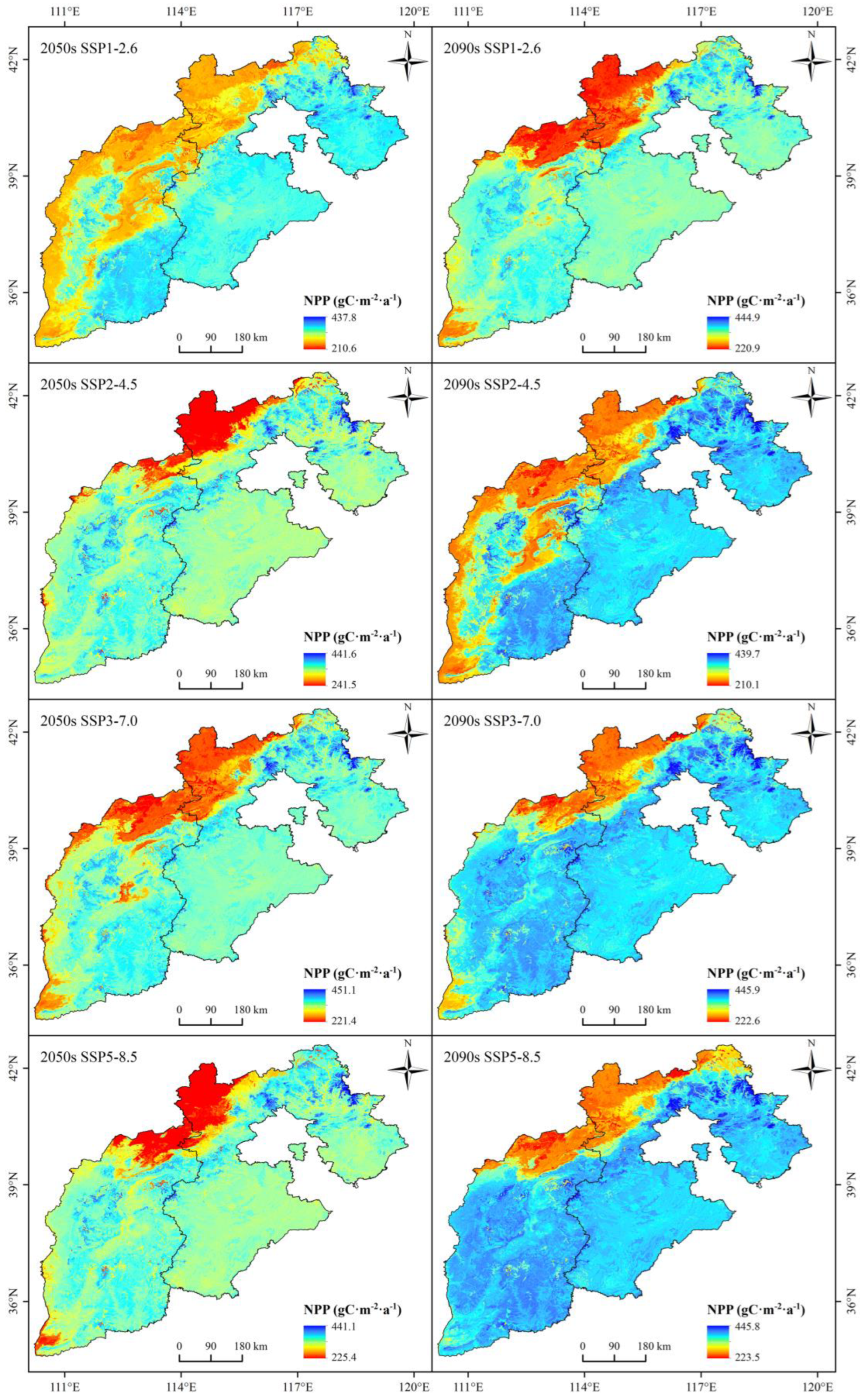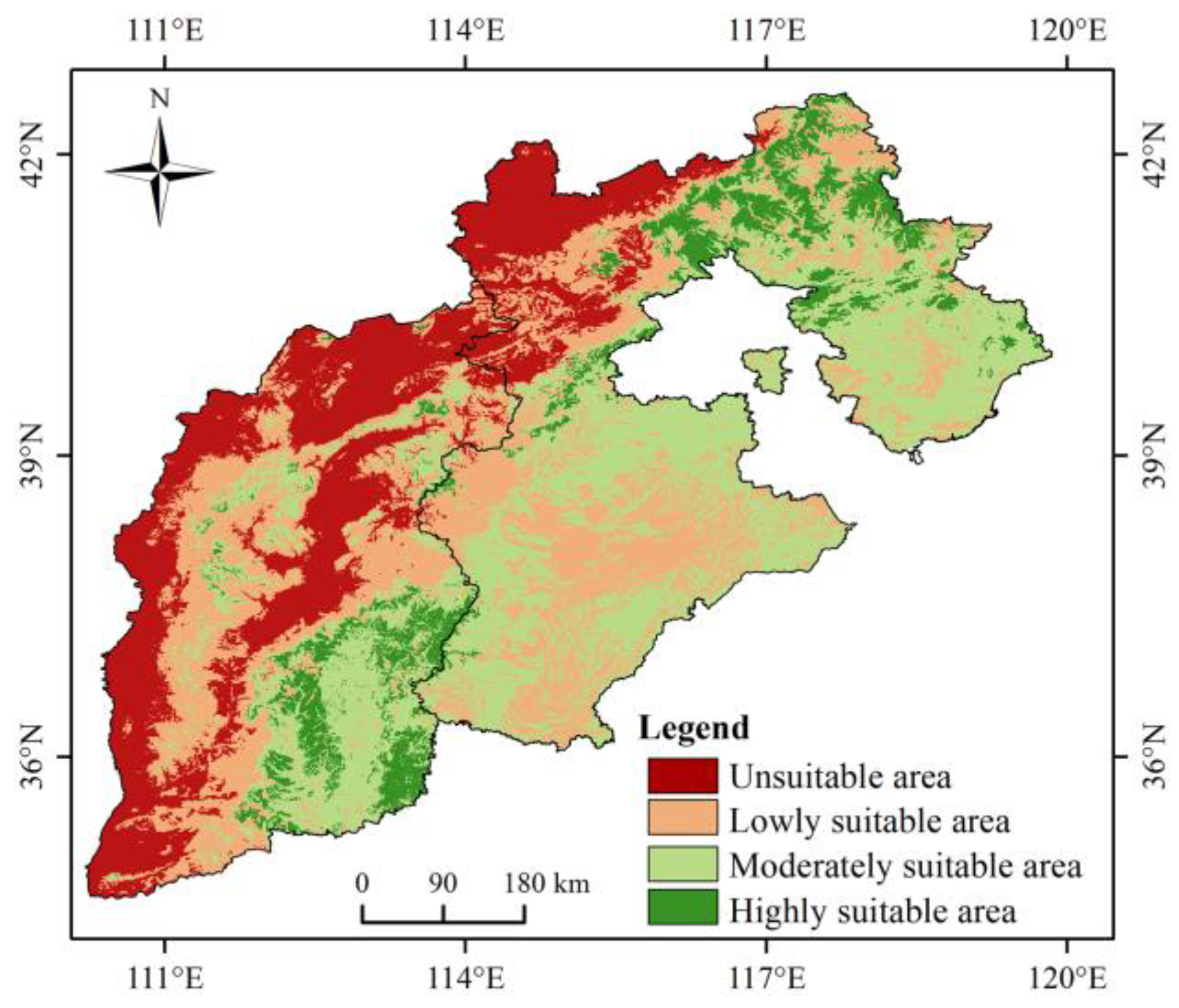Growth Suitability Evaluation of Larix principis-rupprechtii Mayr Based on Potential NPP under Different Climate Scenarios
Abstract
:1. Introduction
2. Materials and Methods
2.1. Study Site
2.2. Data Collection
2.3. Environmental Factor
2.4. Potential NPP Simulation and Model Validation
2.5. Growth Suitability Evaluation
3. Results
3.1. Model Accuracy
3.2. Potential NPP Distribution Pattern
3.3. Growth Suitability Pattern
3.4. Relationship between Temperature and Precipitation and Potential NPP
4. Discussion
5. Conclusions
Author Contributions
Funding
Institutional Review Board Statement
Informed Consent Statement
Data Availability Statement
Acknowledgments
Conflicts of Interest
References
- Jin, J.; Xiang, W.; Zeng, Y.; Ouyang, S.; Zhou, X.; Hu, Y.; Zhao, Z.; Chen, L.; Lei, P.; Deng, X. Stand carbon storage and net primary production in China’s subtropical secondary forests are predicted to increase by 2060. Carbon Balance Manag. 2022, 17, 6. [Google Scholar] [CrossRef] [PubMed]
- Li, T.; Li, M.; Ren, F.; Tian, L. Estimation and spatio-temporal change analysis of NPP in subtropical forests: A case study of Shaoguan, Guangdong, China. Remote Sens. 2022, 14, 2541. [Google Scholar] [CrossRef]
- Paquette, A.; Vayreda, J.; Coll, L.; Messier, C.; Retana, J. Climate change could negate positive tree diversity effects on forest productivity: A study across five climate types in Spain and Canada. Ecosystems 2018, 21, 960–970. [Google Scholar] [CrossRef] [Green Version]
- Liu, X.; Tian, Y.; Liu, S.; Jiang, L.; Mao, J.; Jia, X.; Zha, T.; Zhang, K.; Wu, Y.; Zhou, J. Time-lag effect of climate conditions on vegetation productivity in a temperate forest–grassland ecotone. Forests 2022, 13, 1024. [Google Scholar] [CrossRef]
- Field, C.B.; Barros, V.R.; Dokken, D.J.; Mach, K.J.; Mastrandrea, M.D.; Bilir, T.E.; Chatterjee, M.; Ebi, K.L.; Estrada, Y.O.; Genova, R.C.; et al. Summary for policymakers. In Climate Change 2014: Impacts, Adaptation, and Vulnerability; Assessment Report; The Intergovernmental Panel on Climate Change; Cambridge University Press: Cambridge, UK; New York, NY, USA, 2014; Available online: https://www.ipcc.ch/site/assets/uploads/2018/02/ar5_wgII_spm_en.pdf (accessed on 1 July 2022).
- Sun, G.; Mu, M. Assessing the characteristics of net primary production due to future climate change and CO2 under RCP4. 5 in China. Ecol. Complex. 2018, 34, 58–68. [Google Scholar] [CrossRef]
- Walker, A.P.; Zaehle, S.; Medlyn, B.E.; De Kauwe, M.G.; Asao, S.; Hickler, T.; Parton, W.; Ricciuto, D.M.; Wang, Y.P.; Wårlind, D. Predicting long-term carbon sequestration in response to CO2 enrichment: How and why do current ecosystem models differ? Glob. Biogeochem. Cycles 2015, 29, 476–495. [Google Scholar] [CrossRef]
- Manioudis, M.; Meramveliotakis, G. Broad strokes towards a grand theory in the analysis of sustainable development: A return to the classical political economy. New Political Econ. 2022, 27, 1–13. [Google Scholar] [CrossRef]
- Tomislav, K. The concept of sustainable development: From its beginning to the contemporary issues. Zagreb Int. Rev. Econ. Bus. 2018, 21, 67–94. [Google Scholar] [CrossRef] [Green Version]
- Li, P.; Peng, C.; Wang, M.; Li, W.; Zhao, P.; Wang, K.; Yang, Y.; Zhu, Q. Quantification of the response of global terrestrial net primary production to multifactor global change. Ecol. Indic. 2017, 76, 245–255. [Google Scholar] [CrossRef]
- Liu, Y.; Zhou, R.; Ren, H.; Zhang, W.; Zhang, Z.; Zhang, Z.; Wen, Z. Evaluating the dynamics of grassland net primary productivity in response to climate change in China. Glob. Ecol. Conserv. 2021, 28, e01574. [Google Scholar] [CrossRef]
- Sallaba, F.; Lehsten, D.; Seaquist, J.; Sykes, M.T. A rapid NPP meta-model for current and future climate and CO2 scenarios in Europe. Ecol. Model. 2015, 302, 29–41. [Google Scholar] [CrossRef]
- Wang, B.; Yang, S.; Lv, C.; Zhang, J.; Wang, Y. Comparison of net primary productivity in karst and non-karst areas: A case study in Guizhou Province, China. Environ. Earth Sci. 2010, 59, 1337–1347. [Google Scholar] [CrossRef]
- Lu, L.; Li, X.; Veroustraete, F.; Kang, E.; Wang, J. Analysing the forcing mechanisms for net primary productivity changes in the Heihe River Basin, north-west China. Int. J. Remote Sens. 2009, 30, 793–816. [Google Scholar] [CrossRef]
- Ding, Y.; Liang, S.; Peng, S. Climate change affects forest productivity in a typical climate transition region of China. Sustainability 2019, 11, 2856. [Google Scholar] [CrossRef] [Green Version]
- Chen, X.; Chen, J.; An, S.; Ju, W. Effects of topography on simulated net primary productivity at landscape scale. J. Environ. Manag. 2007, 85, 585–596. [Google Scholar] [CrossRef]
- Huang, X.; Huang, C.; Teng, M.; Zhou, Z.; Wang, P. Net primary productivity of Pinus massoniana dependence on climate, soil and forest characteristics. Forests 2020, 11, 404. [Google Scholar] [CrossRef] [Green Version]
- Reyer, C.; Lasch-Born, P.; Suckow, F.; Gutsch, M.; Murawski, A.; Pilz, T. Projections of regional changes in forest net primary productivity for different tree species in Europe driven by climate change and carbon dioxide. Ann. For. Sci. 2014, 71, 211–225. [Google Scholar] [CrossRef] [Green Version]
- Gonzalez-Benecke, C.A.; Teskey, R.O.; Dinon-Aldridge, H.; Martin, T.A. Pinus taeda forest growth predictions in the 21st century vary with site mean annual temperature and site quality. Glob. Change Biol. 2017, 23, 4689–4705. [Google Scholar] [CrossRef]
- Ji, Y.; Zhou, G.; Luo, T.; Dan, Y.; Zhou, L.; Lv, X. Variation of net primary productivity and its drivers in China’s forests during 2000–2018. For. Ecosyst. 2020, 7, 15. [Google Scholar] [CrossRef] [Green Version]
- Zhang, H.; Sun, R.; Peng, D.; Yang, X.; Wang, Y.; Hu, Y.; Zheng, S.; Zhang, J.; Bai, J.; Li, Q. Spatiotemporal dynamics of net primary productivity in China’s urban lands during 1982–2015. Remote Sens. 2021, 13, 400. [Google Scholar] [CrossRef]
- Guo, Y.; Peng, C.; Trancoso, R.; Zhu, Q.; Zhou, X. Stand carbon density drivers and changes under future climate scenarios across global forests. For. Ecol. Manag. 2019, 449, 117463. [Google Scholar] [CrossRef]
- Huang, Q.; Ju, W.; Zhang, F.; Zhang, Q. Roles of climate change and increasing CO2 in driving changes of net primary productivity in China simulated using a dynamic global vegetation model. Sustainability 2019, 11, 4176. [Google Scholar] [CrossRef] [Green Version]
- Wei, Y.; Wang, L. Simulating alpine vegetation net primary productivity by remote sensing in Qinghai Province, China. J. Mt. Sci. 2014, 11, 967–978. [Google Scholar] [CrossRef]
- Hadian, F.; Jafari, R.; Bashari, H.; Tartesh, M.; Clarke, K.D. Estimation of spatial and temporal changes in net primary production based on Carnegie Ames Stanford Approach (CASA) model in semi-arid rangelands of Semirom County, Iran. J. Arid Land 2019, 11, 477–494. [Google Scholar] [CrossRef] [Green Version]
- Cramer, W.; Kicklighter, D.W.; Bondeau, A.; Moore Iii, B.; Churkina, G.; Nemry, B.; Ruimy, A.; Schloss, A.L.; Model Intercomparison, T. Comparing global models of terrestrial net primary productivity (NPP): Overview and key results. Glob. Change Biol. 1999, 5, 1–15. [Google Scholar] [CrossRef]
- Chen, P. Monthly NPP dataset covering China’s terrestrial ecosystems at North of 18°N (1985–2015). J. Glob. Change Data Discov. 2019, 3, 34–41. [Google Scholar] [CrossRef]
- Wang, Q.; Zeng, J.; Leng, S.; Fan, B.; Tang, J.; Jiang, C.; Huang, Y.; Zhang, Q.; Qu, Y.; Wang, W.; et al. The effects of air temperature and precipitation on the net primary productivity in China during the early 21st century. Front. Earth Sci. 2018, 12, 818–833. [Google Scholar] [CrossRef]
- Sperlich, D.; Nadal-Sala, D.; Gracia, C.; Kreuzwieser, J.; Hanewinkel, M.; Yousefpour, R. Gains or losses in forest productivity under climate change? The uncertainty of CO2 fertilization and climate effects. Climate 2020, 8, 141. [Google Scholar] [CrossRef]
- Hu, X.; He, Y.; Kong, Z.; Zhang, J.; Yuan, M.; Yu, L.; Peng, C.; Zhu, Q. Evaluation of future impacts of climate change, CO2, and land use cover change on global net primary productivity using a processed model. Land 2021, 10, 365. [Google Scholar] [CrossRef]
- Song, L.; Li, M.; Xu, H.; Guo, Y.; Wang, Z.; Li, Y.; Wu, X.; Feng, L.; Chen, J.; Lu, X.; et al. Spatiotemporal variation and driving factors of vegetation net primary productivity in a typical karst area in China from 2000 to 2010. Ecol. Indic. 2021, 132, 108280. [Google Scholar] [CrossRef]
- Yu, B.; Chen, F.; Chen, H. NPP estimation using random forest and impact feature variable importance analysis. J. Spat. Sci. 2017, 64, 173–192. [Google Scholar] [CrossRef]
- Ong, A.K.S.; Prasetyo, Y.T.; Velasco, K.E.C.; Abad, E.D.R.; Buencille, A.L.B.; Estorninos, E.M.; Cahigas, M.M.L.; Chuenyindee, T.; Persada, S.F.; Nadlifatin, R.; et al. Utilization of random forest classifier and artificial neural network for predicting the acceptance of reopening decommissioned nuclear power plant. Ann. Nucl. Energy 2022, 175, 109188. [Google Scholar] [CrossRef]
- Duan, G.; Lei, X.; Zhang, X.; Liu, X. Site index modeling of Larch using a mixed-effects model across regional site types in Northern China. Forests 2022, 13, 815. [Google Scholar] [CrossRef]
- Sun, Y.; Wang, L. Global research progresses in dendroclimatology of Larix Miller. Prog. Geogr. 2013, 32, 1760–1770. [Google Scholar] [CrossRef]
- Cheng, R.; Wang, X.; Jing, Z.; Zhao, J.; Ge, Z.; Zhang, Z. Predicting the Potential Suitable Distribution of Larix principis-rupprechtii Mayr under Climate Change Scenarios. Forests 2022, 12, 1428. [Google Scholar] [CrossRef]
- Lv, Z.; Li, W.; Huang, X.; Zhang, Z. Larix principis-rupprechtii growth suitability based on potential NPP under climate change scenarios in Hebei Province. Sci. Silvae Sin. 2019, 55, 37–44. [Google Scholar] [CrossRef]
- Wu, C.; Chen, D.; Shen, J.; Sun, X.; Zhang, S. Estimating the distribution and productivity characters of Larix kaempferi in response to climate change. J. Environ. Manag. 2021, 280, 111633. [Google Scholar] [CrossRef]
- Fick, S.E.; Hijmans, R.J. WorldClim 2: New 1-km spatial resolution climate surfaces for global land areas. Int. J. Climatol. 2017, 37, 4302–4315. [Google Scholar] [CrossRef]
- Petrie, R.; Denvil, S.; Ames, S.; Levavasseur, G.; Fiore, S.; Allen, C.; Antonio, F.; Berger, K.; Bretonnière, P.A.; Cinquini, L.; et al. Coordinating an operational data distribution network for CMIP6 data. Geosci. Model Dev. 2021, 14, 629–644. [Google Scholar] [CrossRef]
- Waliser, D.; Gleckler, P.J.; Ferraro, R.; Taylor, K.E.; Ames, S.; Biard, J.; Bosilovich, M.G.; Brown, O.; Chepfer, H.; Cinquini, L.; et al. Observations for Model Intercomparison Project (Obs4MIPs): Status for CMIP6. Geosci. Model Dev. 2020, 13, 2945–2958. [Google Scholar] [CrossRef]
- Radosavljevic, A.; Anderson, R.P. Making better Maxent models of species distributions: Complexity, overfitting and evaluation. J. Biogeogr. 2014, 41, 629–643. [Google Scholar] [CrossRef]
- Jiang, X.; An, M.; Zheng, S.; Deng, M.; Su, Z. Geographical isolation and environmental heterogeneity contribute to the spatial genetic patterns of Quercus kerrii (Fagaceae). Heredity 2018, 120, 219–233. [Google Scholar] [CrossRef] [PubMed] [Green Version]
- Dang, A.T.N.; Kumar, L.; Reid, M.; Anh, L.N.T. Modelling the susceptibility of wetland plant species under climate change in the Mekong Delta, Vietnam. Ecol. Inform. 2021, 64, 101358. [Google Scholar] [CrossRef]
- Breiman, L. Random Forests. Mach. Learn. 2001, 45, 5–32. [Google Scholar] [CrossRef] [Green Version]
- Liaw, A.; Wiener, M. Classification and regression by randomForest. R News 2002, 2, 18–22. [Google Scholar]
- Ließ, M.; Glaser, B.; Huwe, B. Uncertainty in the spatial prediction of soil texture: Comparison of regression tree and Random Forest models. Geoderma 2012, 170, 70–79. [Google Scholar] [CrossRef]
- Yang, R.; Zhang, G.; Liu, F.; Lu, Y.; Yang, F.; Yang, F.; Yang, M.; Zhao, Y.; Li, D. Comparison of boosted regression tree and random forest models for mapping topsoil organic carbon concentration in an alpine ecosystem. Ecol. Indic. 2016, 60, 870–878. [Google Scholar] [CrossRef]
- Castaño-Santamaría, J.; López-Sánchez, C.A.; Ramón Obeso, J.; Barrio-Anta, M. Modelling and mapping beech forest distribution and site productivity under different climate change scenarios in the Cantabrian Range (North-western Spain). For. Ecol. Manag. 2019, 450, 117488. [Google Scholar] [CrossRef]
- Yuan, J.; Niu, Z.; Wang, C. Vegetation NPP distribution based on MODIS data and CASA model—A case study of northern Hebei Province. Chin. Geogr. Sci. 2006, 16, 334–341. [Google Scholar] [CrossRef]
- Xie, Y.; Wang, H.; Lei, X. Effects of climate change on net primary productivity in Larix olgensis plantations based on process modeling. Chin. J. Plant Ecol. 2017, 41, 826–839. [Google Scholar] [CrossRef] [Green Version]
- Gang, C.; Zhang, Y.; Wang, Z.; Chen, Y.; Yang, Y.; Li, J.; Cheng, J.; Qi, J.; Odeh, I. Modeling the dynamics of distribution, extent, and NPP of global terrestrial ecosystems in response to future climate change. Glob. Planet. Change 2017, 148, 153–165. [Google Scholar] [CrossRef]
- Fang, W.; Cai, Q.; Zhu, J.; Ji, C.; Yue, M.; Guo, W.; Zhang, F.; Gao, X.; Tang, Z.; Fang, J. Distribution, community structures and species diversity of larch forests in North China. Chin. J. Plant Ecol. 2019, 43, 742–752. [Google Scholar] [CrossRef]
- Lv, Z.; Li, W.; Huang, X.; Zhang, Z. Predicting suitable distribution area of three dominant tree species under climate change scenarios in Hebei Province. Sci. Silvae Sin. 2019, 55, 13–21. [Google Scholar] [CrossRef]
- Oddi, L.; Migliavacca, M.; Cremonese, E.; Filippa, G.; Vacchiano, G.; Siniscalco, C.; Morra di Cella, U.; Galvagno, M. Contrasting responses of forest growth and carbon sequestration to heat and drought in the Alps. Environ. Res. Lett. 2022, 17, 045015. [Google Scholar] [CrossRef]
- Sun, J.; Zhou, T.; Du, W.; Wei, Y. Precipitation mediates the temporal dynamics of net primary productivity and precipitation use efficiency in China’s northern and southern forests. Ann. For. Sci. 2019, 76, 92. [Google Scholar] [CrossRef]
- Rahman, M.S.; Akter, S.; Al-Amin, M. Forest and agro-ecosystem productivity in Bangladesh: A climate vegetation productivity approach. For. Sci. Technol. 2015, 11, 126–132. [Google Scholar] [CrossRef]
- D’Orangeville, L.; Houle, D.; Duchesne, L.; Phillips, R.P.; Bergeron, Y.; Kneeshaw, D. Beneficial effects of climate warming on boreal tree growth may be transitory. Nat. Commun. 2018, 9, 3213. [Google Scholar] [CrossRef] [Green Version]
- Fang, O.; Wang, Y.; Shao, X. The effect of climate on the net primary productivity (NPP) of Pinus koraiensis in the Changbai Mountains over the past 50 years. Trees 2015, 30, 281–294. [Google Scholar] [CrossRef]
- Lebourgeois, F.; Bréda, N.; Ulrich, E.; Granier, A. Climate-tree-growth relationships of European beech (Fagus sylvatica L.) in the French Permanent Plot Network (RENECOFOR). Trees 2005, 19, 385–401. [Google Scholar] [CrossRef]
- Xie, Y.; Lei, X.; Shi, J. Impacts of climate change on biological rotation of Larix olgensis plantations for timber production and carbon storage in northeast China using the 3-PGmix model. Ecol. Modell. 2020, 435, 109267. [Google Scholar] [CrossRef]








| Environment Variables | Code | Variable Name | Unit |
|---|---|---|---|
| Temperature | BIO4 | Temperature seasonality (standard deviation × 100) | - |
| BIO5 | Max temperature of warmest month | °C | |
| BIO10 | Mean temperature of warmest quarter | °C | |
| Precipitation | BIO13 | Precipitation of wettest month | mm |
| BIO18 | Precipitation of warmest quarter | mm | |
| Terrain | ELEV | Elevation | m |
| SLP | Slope based on a digital elevation model | ° | |
| ASP | Aspect based on a digital elevation model | % | |
| Soil | AN | Soil alkali-hydrolysis nitrogen | mg·kg−1 |
| AP | Available phosphorus | mg·kg−1 | |
| TK | Soil total kalium | g·kg−1 | |
| TN | Soil total nitrogen | g·kg−1 | |
| TP | Soil total phosphorus | g·kg−1 | |
| SOM | Soil organic matter | % | |
| GRAV | Soil rock fragment | % | |
| CLAY | Percentage of clay in soil | % | |
| SAND | Percentage of sand in soil | % | |
| BD | Soil bulk density | g·cm−3 |
| Scenarios | Periods | Range (gC·m−2·a−1) | Mean (gC·m−2·a−1) | Unsuitable (%) | Lowly (%) | Moderately (%) | Highly (%) |
|---|---|---|---|---|---|---|---|
| - | Current | 175.2–513.9 | 324.9 | 32.3 | 23.0 | 38.4 | 6.3 |
| SSP1-2.6 | 2050s | 210.6–437.8 | 320.1 | 27.8 | 10.5 | 34.3 | 27.4 |
| 2090s | 220.9–444.9 | 339.0 | 14.5 | 9.4 | 51.2 | 24.8 | |
| SSP2-4.5 | 2050s | 241.5–441.6 | 347.0 | 7.9 | 12.3 | 54.9 | 25.0 |
| 2090s | 210.1–439.7 | 327.2 | 23.4 | 9.8 | 43.4 | 23.3 | |
| SSP3-7.0 | 2050s | 211.4–451.1 | 336.6 | 15.9 | 11.1 | 52.4 | 20.6 |
| 2090s | 222.6–445.9 | 340.2 | 12.3 | 9.5 | 51.1 | 27.1 | |
| SSP5-8.5 | 2050s | 225.4–441.1 | 345.5 | 8.2 | 8.4 | 54.0 | 29.4 |
| 2090s | 223.5–445.8 | 339.4 | 13.5 | 5.7 | 47.3 | 33.5 |
Disclaimer/Publisher’s Note: The statements, opinions and data contained in all publications are solely those of the individual author(s) and contributor(s) and not of MDPI and/or the editor(s). MDPI and/or the editor(s) disclaim responsibility for any injury to people or property resulting from any ideas, methods, instructions or products referred to in the content. |
© 2022 by the authors. Licensee MDPI, Basel, Switzerland. This article is an open access article distributed under the terms and conditions of the Creative Commons Attribution (CC BY) license (https://creativecommons.org/licenses/by/4.0/).
Share and Cite
Cheng, R.; Zhang, J.; Wang, X.; Zhang, Z. Growth Suitability Evaluation of Larix principis-rupprechtii Mayr Based on Potential NPP under Different Climate Scenarios. Sustainability 2023, 15, 331. https://doi.org/10.3390/su15010331
Cheng R, Zhang J, Wang X, Zhang Z. Growth Suitability Evaluation of Larix principis-rupprechtii Mayr Based on Potential NPP under Different Climate Scenarios. Sustainability. 2023; 15(1):331. https://doi.org/10.3390/su15010331
Chicago/Turabian StyleCheng, Ruiming, Jing Zhang, Xinyue Wang, and Zhidong Zhang. 2023. "Growth Suitability Evaluation of Larix principis-rupprechtii Mayr Based on Potential NPP under Different Climate Scenarios" Sustainability 15, no. 1: 331. https://doi.org/10.3390/su15010331




